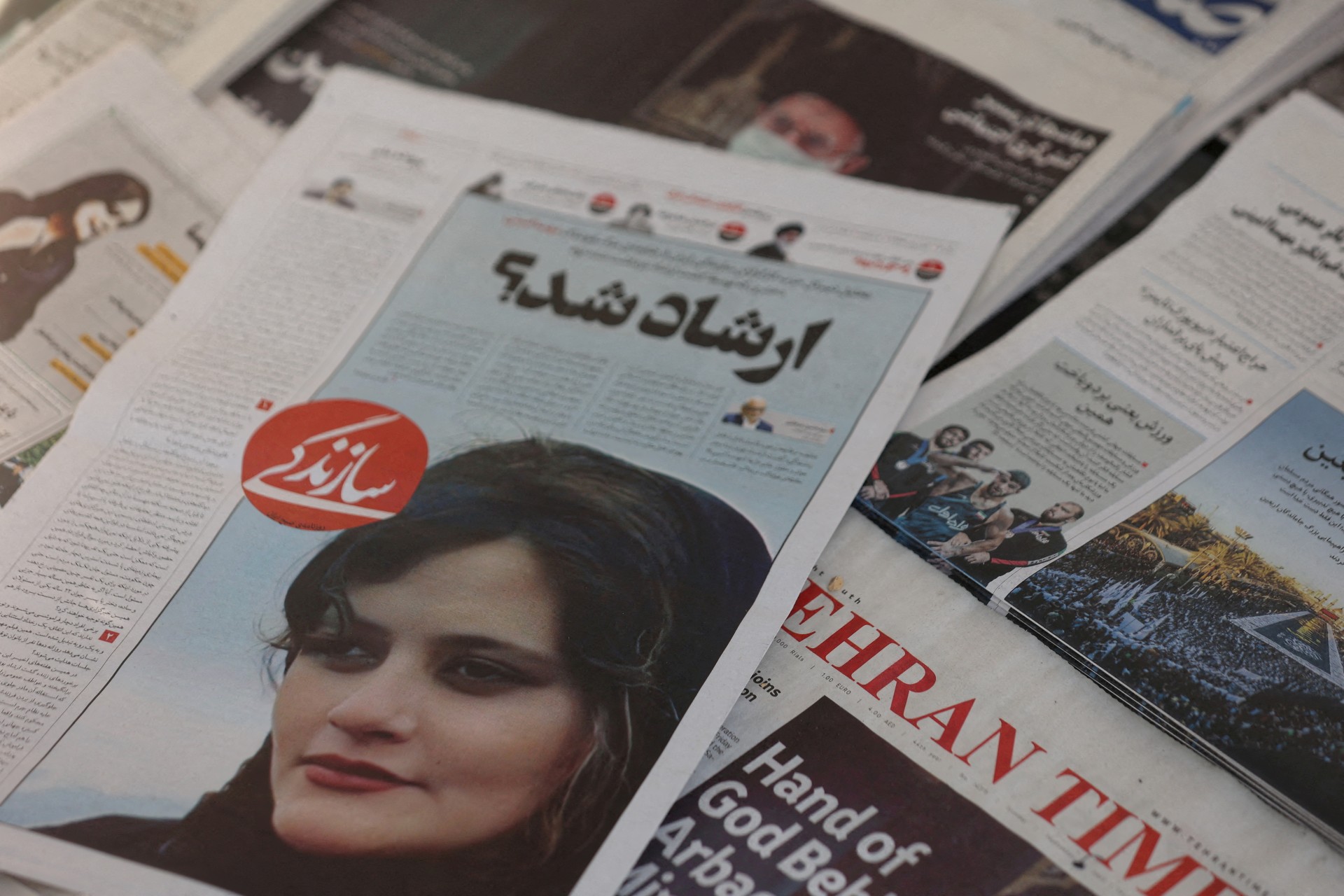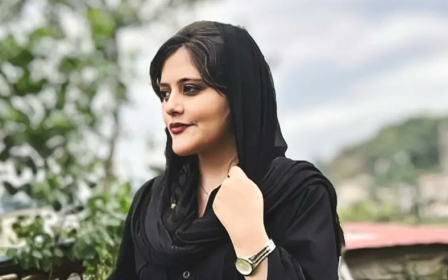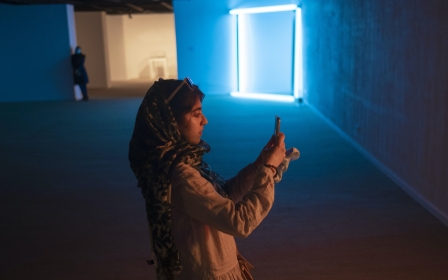Mahsa Amini: Iran's raging protests draw sympathy from all corners of society

As teargas swirled on the streets and authorities moved to dispel the women who had gathered in rage and defiance, Poori*, a 31-year-old physics graduate, insisted on standing her ground.
“I was out there. I feel like my chest and throat are burning as a result of teargas,” she told Middle East Eye.
Poori was at one of dozens of protests that have broken out across Iran over the past four days, sparked by the death in custody of a young woman who was arrested by Iran’s so-called “morality police”, who were enforcing the country’s strict regulations on women wearing the hijab.
Though Poori willingly wears a headscarf, she disagrees with Iran’s strict laws on women’s dress.
“It was totally worth it," she says of the protest. "I saw the amazing moment when the other girls were twirling their scarves in the air and shouting ‘Woman, life, and freedom.'”
New MEE newsletter: Jerusalem Dispatch
Sign up to get the latest insights and analysis on Israel-Palestine, alongside Turkey Unpacked and other MEE newsletters
Mahsa Amini lived in the small city of Saqqez in Kurdistan province, but was visiting Tehran when she was arrested outside a metro station. The “morality police” are often positioned outside metro stations, where they look for loose hijabs.
Soon after the 22-year-old’s arrest, the authorities said she had died of a stroke. But allegations of beatings and torture began to circulate, reportedly meted out after Amini challenged the police’s motivations and efforts to detain her.
Her father, who denies there was any issue with her clothing, says there were bruises on her body. According to some media reports, radiology images suggest Amini was beaten.
Iranian women have been subject to modest dress codes since the Islamic Revolution of 1979, but since President Ebrahim Raisi came to power last year, the “morality police” have stepped up their activities, enforcing the hijab law to a stricter degree.
Amini’s death touched a nerve. In several cities, Iranians have gathered on the streets to denounce the “morality police” and the government. At many of the demonstrations, women have been removing their headscarves and setting them on fire.
'I saw the amazing moment when the other girls were twirling their scarves in the air and shouting "Woman, life, and freedom"'
- Poori, protester
Protests of this scale are unusual in Iran, and often subject to brutal and deadly crackdowns. In 2019, more than 300 protesters and bystanders were killed by authorities during anti-government demonstrations, according to rights groups.
Security presence has been stepped up in major cities, including Tehran, Mashhad and Rasht, but many others are also rocked by demonstrations.
Saqqez, Amini’s hometown, has also witnessed serious protests, with officials shutting down the internet in an attempt to quell the disturbances and stop more images from circulating online. The same has been witnessed in other cities and parts of Tehran. Eisa Zarepour, the communications minister, confirmed this on Wednesday.
Many protests have been violently suppressed by the security forces. Government officials confirmed that at least three protesters have been killed so far.
Some are fighting back. According to the state-run IRNA news agency, four police officers have been wounded and one “police associate” has been killed.
Footage emerging on Tuesday showing security forces fleeing protests and their vehicles being set on fire.
In Tehran, despite the presence of security forces, people have gathered in several areas, including Valiasr Square. However, anti-riot forces used batons and teargas to disperse the crowd.
The police have sent text messages to people’s phones, urging them to leave the streets, saying they want to “deal with the ones who are causing insecurity”.
A new kind of protest
In the past two decades Iran has witnessed several major protests, including the deadly demonstrations in 2019, mostly over poor economic conditions. But observers believe there is a stark difference between today’s protests and previous ones.
Speaking on condition of anonymity, a political journalist told MEE: “What I’m seeing is a large number of people united for reaching their goals.
“Unlike previous protests, today people are chanting slogans and risking their life for a cultural demand, which is an end to the compulsory hijab and oppressing Iranian women,” he said.
'Unlike previous protests, today people are chanting slogans and risking their life for a cultural demand, which is an end to the compulsory hijab and oppressing Iranian women'
- Iranian journalist
“In the 2019 protests, people from the poor class mostly took part in the demonstrations. But today, people from all classes, with different thoughts, are taking to the streets. Many people who have hijab, too, are also present in the streets, along with others who all want an end to the compulsory hijab.”
The journalist, who has been out on the streets amid the demonstrations, said sympathy for the protesters is coming from unusual places.
“Even the most religious people and those loyal to the Islamic Republic have been moved by the brutality of the police against Mahsa Amini, and are, to some extent, having sympathy with protesters.”
Farah* is a 43-year-old woman who wears a chador. She disagrees with the compulsory hijab, describing the Islamic Republic’s behaviour as “damaging the whole of Islam. They are causing insecurity for women like me who wear hijab, as some angry young men mistakenly see us as the supporters of the state.”
Among principalists, the conservative political camp sometimes known as hardliners, a division over the Amini issue is becoming increasingly pronounced, with many conservatives also angered by her death.
“I believe that the government is itself making the protests violent in order to have a pretext to crush them," said a political analyst, speaking anonymously due to security concerns.
"The result is that some hardliners have now grown worried about the protests, while a few days ago they had sympathy with people against police. Moreover, the government and its supporters are saying that protesters have set two mosques on fire.”
He said these tactics are “old tricks” used by authorities and seen in 2009, when supporters of the reformist politicians protested against the presidential election result that put principalist Mahmoud Ahmadinejad in power for a second term.
“By doing so, they want to provoke the hardline base to not have any sympathy with protesters and also prepare a pretext for themselves to crack down on people.”
Meanwhile, celebrities are becoming more vocal, using language unprecedented in its harshness.
Ali Karami, a legendary figure in Iranian football, has been highly active lately. He posted a video of security forces beating women on the streets, calling them “bastards”. Pantea Bahram, a famous actor, also called security forces a “bunch of traitors”.
Results unclear
Though the crackdown is not yet at the levels seen in 2019 or 2009, further deadly violence cannot be ruled out. And it’s not clear what this emotional and directionless outpouring can achieve.
Speaking on condition of anonymity, a Tehran-based political analyst told MEE: “Although this demonstration is significant in terms of dimensions and scope, it is unlikely to reach a specific result, due to the lack of leadership or any organised behaviour.
“I feel that these protests will only be limited to people venting out their anger, which will, unfortunately, end with a severe repression by the government,” he added.
“There is no specific goal in the protests. Some people want an end to the compulsory hijab, some want an end to the ‘morality police’, and some want the Islamic Republic to be overthrown.”
According to a former official in the moderate political camp, any concessions by the government would be dangerous.
“The system has no way except resisting. If it takes a step back, there would be serious repercussions for it. If the system retreats and puts an end to the ‘morality police”, the next step would be an end to compulsory hijab, which is among the identities of the system. So, it won’t happen,” he said.
“Therefore, violent repression of the protests is not something that would surprise us.”
*Some names have been changed
This article is available in French on Middle East Eye French edition.
Middle East Eye delivers independent and unrivalled coverage and analysis of the Middle East, North Africa and beyond. To learn more about republishing this content and the associated fees, please fill out this form. More about MEE can be found here.






